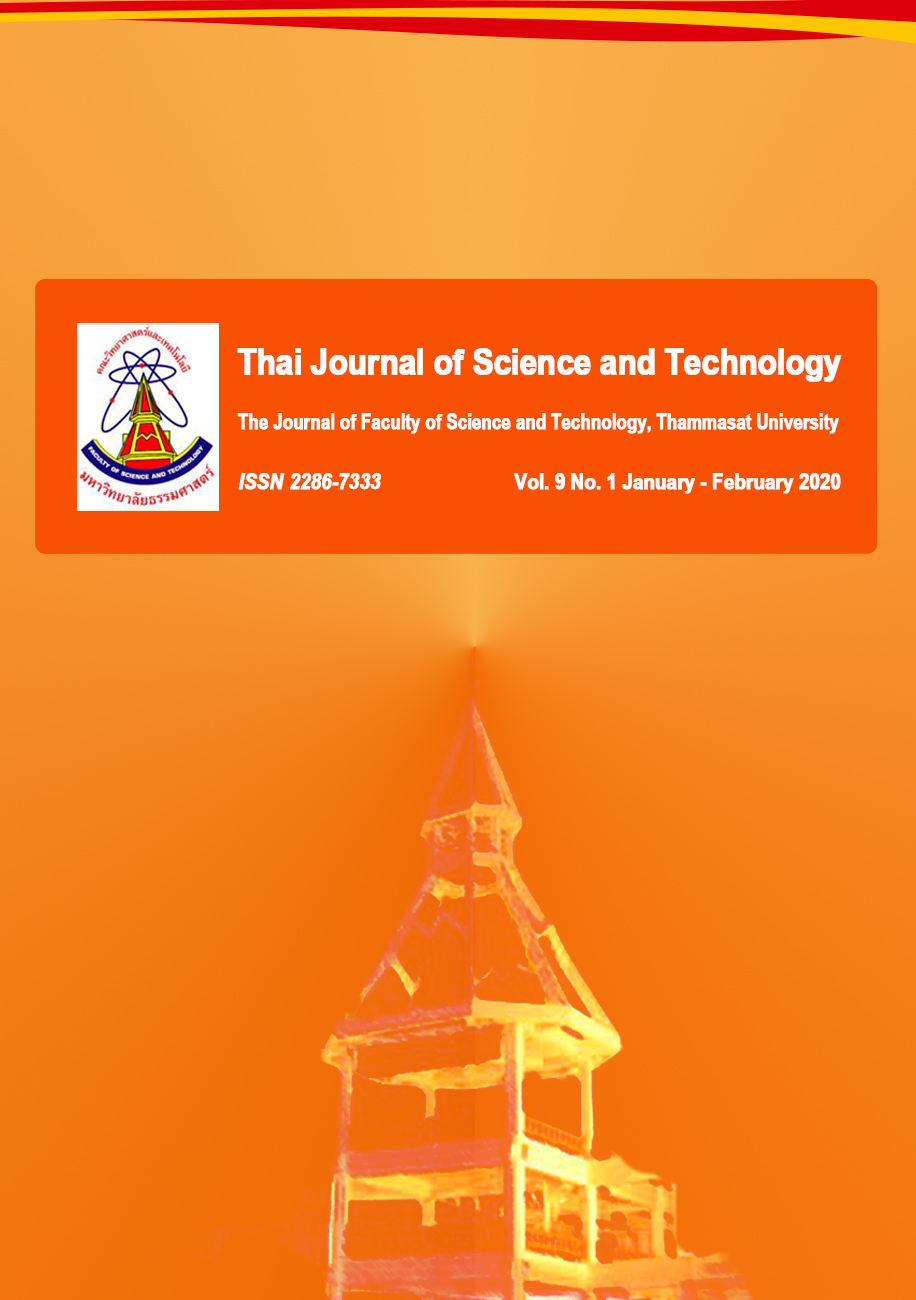ฤทธิ์ชีวภาพของสารสกัดจากมะยมในการยับยั้งสื่อสัญญาณแคลเซียม การยับยั้งจุลินทรีย์ และการต้านอนุมูลอิสระ
Main Article Content
Abstract
Crude ethanol extracts of leaf and stem of Phyllanthus acidus (L.) Skeel were investigated on its biological activities i.e. the inhibition of hyper-activated Ca2+ signaling, antimicrobial growth and antioxidants activity. The Ca2+-signal inhibitory activity was performed using Saccharomyces cerevisiae zds1D-growth base assay on YPD soft agar supplemented with 165 mM CaCl2. Crude leaf extract exhibited inhibitory activity on Ca2+-signal when 5.00 and 1.67 mg of sample were used, while crude stem extract could not attenuate the hyper-activated Ca2+-signal inhibition growth of the strain. Antimicrobial activity of crude extracts was accomplished by disc diffusion following broth microdilution and agar dilution assays. Results showed that crude stem extract inhibited growth of tested-microorganisms such as Enterobacter aerogenes TISTR1540, Bacillus subtilis TISTR008, Staphylococcus aureus TISTR885 and Saccharomyces cerevisiae TISTR5013. The S. aureus TISTR885 was demonstrated the highest susceptibility on crude stem extract with 7.81 and 31.25 mg/mL for minimum inhibitory concentration (MIC) and minimal bactericidal concentration (MBC), respectively. Crude leaf extract inhibited growth of Candida albicans TISTR5779 with 31.25 and 125 mg/mL for MIC and minimum fungicidal concentration (MFC), respectively. However, both of crude ethanol extracts could not inhibit growth of Escherichia coli TISTR780 at 1,000 mg/mL of crude extract concentration used. Furthermore, antioxidant activity using the DPPH and ABTS assay of crude stem extract was higher than that of crude leaf extract. Crude stem extract exhibited the IC50 value on scavenging activity of DPPH and of ABTS cation radical with 30.34 and 46.09 µg/mL, respectively. In addition, total phenolic content of crude stem and leaf extract was 68.95±0.02 and 47.37±0.01 µg GAE/mg crude extract, respectively.
Article Details
บทความที่ได้รับการตีพิมพ์เป็นลิขสิทธิ์ของคณะวิทยาศาสตร์และเทคโนโลยี มหาวิทยาลัยธรรมศาสตร์ ข้อความที่ปรากฏในแต่ละเรื่องของวารสารเล่มนี้เป็นเพียงความเห็นส่วนตัวของผู้เขียน ไม่มีความเกี่ยวข้องกับคณะวิทยาศาสตร์และเทคโนโลยี หรือคณาจารย์ท่านอื่นในมหาวิทยาลัยธรรมศาสตร์ ผู้เขียนต้องยืนยันว่าความรับผิดชอบต่อทุกข้อความที่นำเสนอไว้ในบทความของตน หากมีข้อผิดพลาดหรือความไม่ถูกต้องใด ๆ
References
Attrapadung, S., Yoshida, J., Kimura, K., Mizunuma, M., Miyakawa, T. and Thanomsub, B.W., 2009, Identifcation of ricinoleic acid as an inhibitor of Ca2+ signal mediated cell-cycle regulation in budding yeast, FEMS Yeast Res. 10: 38-43.
Bezprozvanny, I., 2009, Calcium signaling and neurodegenerative diseases, Trends Mol. Med. 15: 89-100.
Capiod, T., Shuba, Y., Skryma, R. and Prevarskaya, N., 2007, Calcium signalling and cancer cell growth, Subcell. Biochem. 45: 405-427.
Chanklan, R., Aihara, E., Koga, S., Takahashi, H.,
Mizunuma, M. and Miyakawa, T., 2008a, Inhibition of Ca2+-signaling-dependent growth regulation by radicicol in budding yeast, Biosci. Biotechnol. Biochem. 72: 132-138.
Chanklan, R., Mizunuma, M., Kongkathip, N., Hasitapan, K., Kongkathip, N. and Miyakawa, T., 2008b, Identification of Saccharomyces cerevisiae Tub1 -tubulin as a potential target for NKH-7, a cytotoxic 1-naphthol derivative compound, Biosci. Biotechnol. Biochem. 72: 1023-1031.
Habib, M.R., Sayeed, M.A., Rahman, M.M., Hasan, M.R. and Saha, A., 2011, In vitro evaluation of cytotoxic, antibacterial, antioxidant and phytochemical screening of petroleum ether extract of Phyllanthus acidus, Int. J. Appl. Bio. Pharm. Tech. 2: 420-427.
Jagessar, R.C., Mars, A. and Gomes, G., 2008, Selective antimicrobial properties of Phyllanthus acidus leaf extract against Candida albicans, Escherichia coli and Staphylococcus aureus using stokes disc diffusion, well diffusion, streak plate and a dilution method, Nat. Sci. 6: 24-38.
Jain, N.K. and Singhai, A.K., 2011, Protective effects of Phyllanthus acidus (L.) Skeels leaf extracts on acetaminophen and thioacetamide induced hepatic injuries in Wistar rats, Asian Pac. J. Trop. Med. 4: 470-474.
Leeya, Y., Mulvany, M.J., Queiroz, E.F., Marston, A., Hostettmann, K. and Jansakul C., 2010, Hypotensive activity of an n-butanol extract and their purified compounds from leaves of Phyllanthus acidus (L.) Skeels in rats, Eur. J. Phamacol. 649: 301-313.
Lui, W., Lui, J., Yin, D. and Zhao, X., 2015, Influence of ecological factors on the production of active substances in the anti-cancer plant Sinopodophyllum hexandrum (Royle) T.S. Ying, PLoS One. 10: e0122981.
Nguyen, T.T.K., Laosinwattana, C., Teerarak, M. and Pilasombut, K., 2017, Potential antioxidant and lipid peroxidation inhibition of Phyllantus acidus leaf extract in minced pork, Asian-Australas. J. Anim. Sci. 30: 1323-1331.
Ogasawara, Y., Yoshida, J., Shiono, Y., Miyakawa, T. and Kimura, K., 2008, New Eremophilane sesquiterpenoid compounds, Eremoxylarins A and B directly inhibit calcineurin in a manner independent of immunophilin, J. Antibiot. 61: 496-502.
Rahman, M.M., Habib, M.R., Hasan, S.M.R., Sayeed, M.A. and Rana, M.S., 2011, Antibacterial, cytotoxic and antioxidant potential of methanolic extract of Phyllanthus acidus L., Int. J. Drug Dev. Res. 3: 154-161.
Re, R., Pellegrini, N., Proteggente, A., Pannala, A., Yang, M. and Rice-Evans, C., 1999, Antioxidant activity applying an improved ABTS radical cation decolorization assay, Free Radic. Biol. Med. 26: 1231-1237.
Rusnak, F. and Mertz, P., 2000, Calcineurin: Form and function, Physiol. Rev. 80:1483-1521.
Sarker, S.D., Nahar, L. and Kumarasamy, Y., 2007, Microtitre plate-based antibacterial assay incorporating resazurin as an indicator of cell growth, and its application in the in vitro antibacterial screening of phytochemicals, Methods 42: 321-324.
Shitamukai, A., Mizunuma, M., Hirata, D., Takahashi, H. and Miyakawa, T., 2000, A Positive screening for drugs that specifically inhibit the Ca2+-signaling activity on the basis of the growth promoting effect on a yeast mutant with a peculiar phenotype, Biosci. Biotechnol. Biochem. 64: 1942-1946.
Subrata, K.B., Anusua, C., Joysree, D., Utpal, K.K., Manik, C.S., and Sheikh, Z.R., 2011, Assessment of cytotoxicity, antibacterial activity and phytochemical screening of ethanol extract of Phyllanthus acidus L. (family: Euphorbiacceae ) bark, J. Appl. Pharm. Sci., 6:112-114.
Unander, D.W., Webster, G.L. and Blumberg, B.S., 1995, Usage and bioassays in Phyllanthus (Euphorbiaceae). IV. Clustering of antiviral uses and other effect, J. Ethnopharmacol. 45: 1-18.
Velioglu, Y.S., Mazza, G., Gao, L. and Oomah, B.D., 1998, Antioxidant activity and total phenolics in selected fruits, vegetables, and grain products, J. Agric. Food Chem. 46: 4113-4117.
Vongvanich, N., Kittakoop, P., Kramyu, J., Tanticharoen, M. and Thebtaranonth, Y., 2000, Phyllanthusols A and B, cytotoxic norbisabolane glycosides from Phyllanthus acidus Skeels, J. Org. Chem. 65: 5420-5423.
Yamasaki, K., Hashimoto, A., Kokusenya, Y., Miyamoto, T. and Sato, T., 1994, Electrochemical method for estimating the antioxidative effects of methanol extracts of crude drugs, Chem. Pharm. Bull. (Tokyo) 42: 1663-1665.
Yoshida, J., Nomura, S., Nishizawa, N., Ito, Y. and Kimura, K., 2011, Glycogen synthase kinase-3β inhibition of 6-(methylsulfinyl) hexyl isothiocyanate derived from wasabi (Wasabi japonica Matsum), Biosci. Biotechnol. Biochem. 75: 136-139.


